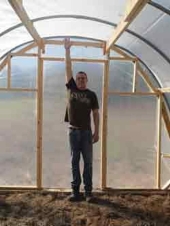

Benjamin Dinkel wrote:
The condensation that you're talking about will happen when you cool down hot (moist) air and will happen inside the tubes, not in contact with the backfill. So I don't see why it shouldn't work with heavy clay. It might actually be your best material.
Anne Miller wrote:
My understanding of earth tubes is that they only work if constructed at deeper depth and level.
Anne Miller wrote:What a bummer. I hate breaking light bulbs.
If that happened to me I would be looking for a new place where my seedling could get light.
Mercury contamination is only a thought when I break a thermometer ...

John F Dean wrote:I have a well stocked barn. I enclosed the ends of my high tunnel with a couple of storm doors and some storm windows.
Anne Miller wrote:Would something like this work:

source


Skandi Rogers wrote:For me it's a no go, since I need the extra heat the tunnel provides, even July nights can go under 10C here so it needs to be shut every night and then opened up by 7 or 8 in the morning to stop it roasting.

John F Dean wrote:I frequently leave my high tunnel unattended that long. Of course, the devil is in the details. In very cold weather, I check on it a couple of times a day.
